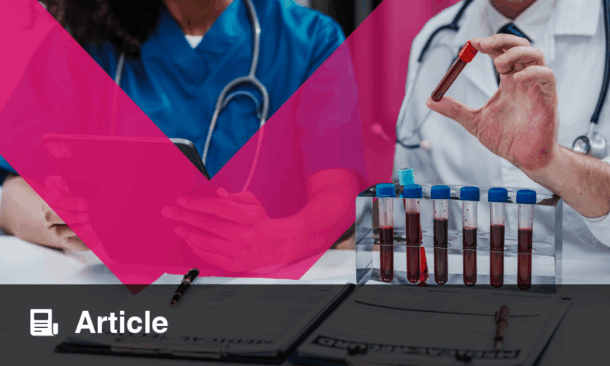Konstanze Döhner | President Elect, European Hematology Association (EHA); Assistant Professor and Head of the Myeloid Neoplasms Section, Department of Internal Medicine III, University Hospital of Ulm, Germany
Citation: EMJ Hematol. 2025;13[1]: 68-71. https://doi.org/10.33590/emjhematol/EBSJ8988
![]()
As the incoming President of the European Hematology Association (EHA), what are your top priorities for the coming term?
My top priorities as EHA President align closely with the association’s strategic roadmap, which we have developed and begun to implement over the past 2 years. At the core of this roadmap are five key ambitions that will guide our work.
The first ambition is nurturing knowledge and professional growth. To give an example of what that means, we are expanding our EHA Campus with new interactive content and personalised learning tools, making high-quality haematology education accessible globally, anytime, anywhere. This supports continuous professional development across all career stages.
The second ambition is fostering innovation, and here we have a lot of activities to offer, for example, the EHA Kick-off Grant and the EHA Innovation Grant. We are encouraging cutting-edge ideas with these grants, whether in diagnostics, digital health, or new therapeutic approaches. Moreover, we strongly promote collaboration between academic partners from different countries.
Another ambition is advancing research for real breakthroughs. This means that we support investigator-driven studies through our large and intensive collaborations with scientific networks and joint research initiatives, such as our three Research Training Programs: the EHA-ASH (American Society of Hematology) Translational Research programme, the EHA Clinical Research Training in Hematology programme, and the EHA-EMBL/EBI (European Molecular Biology Laboratory’s European Bioinformatics Institute) Computational Biology Training in Hematology programme. These programmes help to accelerate impactful haematology research.
Ensuring equitable access to care is another ambition, and here we advocate for better access to drugs and diagnostics across Europe, especially in the under-resourced regions and countries. EHA plays a very important role in European-level policy discussions to reduce inequalities in patient care.
The last ambition is empowering a strong, connected haematology community, particularly we are building a stronger network with our national societies. We are also strengthening many collaborations and advancing Diversity, Equity, and Inclusion through our DEI programme. This is done within our leadership, events, and outreach. The Young EHA committee is vital in supporting the next generation of haematologists.
In addition to supporting these collective goals, I’m personally committed to strengthening EHA’s role in supporting haematologists from underrepresented countries, particularly in terms of access to education, research, career development, clinical trials, and treatment. I’m also committed to maintaining financial sustainability so that EHA remains a robust and forward-looking organisation.
Another important priority is staying connected to our members, listening to their needs, and ensuring that EHA is an inclusive, responsive, and supportive community for haematologists across all career stages and areas of specialisation.
Ultimately, my goal is to ensure that EHA continues to be a modern, impactful organisation that advances haematology across Europe and beyond.
What are the most pressing challenges facing haematology research and patient care across Europe today? How do you envision EHA playing a proactive role in addressing these, from regulatory hurdles to funding gaps and disparities in access to care?
One of the most urgent challenges today is the growing disparity in access to care across Europe. While some countries have access to cutting-edge diagnostics, clinical trials, and novel therapies, others still struggle with the availability of basic treatments and medication. This inequity not only affects patient outcomes but also slows down the collective progress in the field.
Another pressing issue is sustainable research funding, particularly for basic and translational research. Early career researchers often face difficulties in securing stable support and funding, and this risks us losing the next generation of haematology innovators.
In addition, the regulatory environment remains very complex and fragmented, especially when it comes to data sharing, cross-border clinical trials, and the implementation of new technologies like cell and gene therapies. This slows down innovation and patient access. EHA is actively working to address these challenges at multiple levels. We are advocating at the European Union level for harmonised rules (for example, in the European Health Data Space and the upcoming Biotech Act) and for greater investment in haematology research. Through our work on these various initiatives and in collaboration with the ASH, we help to support data-driven research and cross-border projects.
We also continue to expand our educational support, including grants, fellowships, and training programmes. Importantly, we are committed to supporting underserved regions, including through EHA memberships, targeted capacity building, and partnerships with our national societies. Our goal is to ensure that all haematology professionals and patients, regardless of where they are in Europe, can benefit from the latest scientific advances and standards of care.
EHA often speaks of ‘Borderless Hematology’. How is the association actively removing barriers for haematologists across Europe and beyond?
‘Borderless Hematology’ is much more than a slogan. It reflects EHA’s deep commitment to ensuring that geography, resources, or politics do not limit access to knowledge, collaboration, or care. We are actively removing barriers in several key ways.
To give an example, ‘education without borders’. Through our EHA Campus, our digital learning platform, haematologists around the world can access high-quality, up-to-date educational resources, anytime, anywhere, free or at minimal costs. EHA also supports mobility grants, as well as research through fellowships and collaborative grants. This includes specific programmes to help colleagues in underrepresented regions and countries have access to training or pursue international projects.
We also take care of our global partnerships. We work very closely with ASH and our national societies around the world, including those in Africa, Asia, and Latin America. Here, we aim to harmonise training, exchange expertise, and strengthen haematology globally.
Now we come to policy and advocacy, which is another very important element of EHA’s work. EHA is very active in Brussels, working to remove regulatory barriers that hinder collaborative research and cross-border clinical trials in Europe.
For example, EHA is actively engaged with the European Union institutions as well as the European Medicines Agency (EMA) to address the complex regulations that make it difficult to run multinational clinical trials across Europe. We’re an active stakeholder with nominated representatives in the Accelerating Clinical Trials in the EU (ACT EU) initiative, aimed at improving the design, efficiency, and effectiveness of clinical trials in Europe. We’re also leading a multistakeholder coalition and campaign to reduce bureaucracy in clinical trials (RBinCT).
Regarding patient access and health equity, we work to ensure that regulatory reforms prioritise affordability and equity in patient access to diagnostics and treatment across all European member states. This involves contributing to discussions on the SoHO (Substances of Human Origin) and pharmaceutical legislation, EU Health Technology Assessment (HTA), and pricing and reimbursement, for example, through our participation in the EU-funded ASCERTAIN project. EHA is also involved in shaping the European Health Data Space (EHDS), pushing for legislation that enables the seamless, secure, and privacy-preserving sharing of health data for research purposes across borders. This is critical for leveraging real-world evidence and AI, as well as for biomarker discovery.
EHA is also an active and leading member of the BioMed Alliance, where we jointly advocate for better EU policies and funding schemes, such as Horizon Europe. Finally, we implement diversity, equity, and inclusion, our DEI programme, in all of our activities. We are committed to supporting a diverse and inclusive haematology community, and this includes creating opportunities for professionals from various backgrounds, regardless of their location.
Ultimately, “Borderless Hematology” means that no matter where a haematologist lives or works, they should be part of a connected, empowered, and well-supported global community.
Reflecting on EHA2025, what key scientific trends, breakthroughs, or innovations have emerged from this year’s Congress, and how do you see them shaping the future of haematology?
A very positive development is that we can increasingly offer tailored therapies for many haematological diseases. This is a clear trend towards precision haematology. In addition, there were many presentations clearly demonstrating promising oral combinations, as well as intensive triplet therapy and combination therapies. One drug, a menin inhibitor, has been shown to be very active in the treatment of acute leukaemia. These achievements suggest a kind of paradigm shift towards more accessible outpatient-based targeted therapies that significantly improve tolerability and the outcomes of patients; however, this is particularly true for older or frailer patients.
Our Congress also included novel aspects regarding CAR-T cell therapy and presented cutting-edge data on upfront treatment strategies. These insights highlight a new era, where cell therapies are not just a salvage option, but are being increasingly integrated into standard treatment algorithms. We then had multiple sessions addressing the integration of AI and big data in diagnostics, prediction, prognosis, and personalised treatment planning.
One other important part of our Congress is bridging the gap between clinical topics and the policy and regulatory domain, as well as deepening our stakeholder engagement. Our European Affairs track featured joint symposia in collaboration with the EMA and patient organisations, with multistakeholder sessions, focusing on quality of life and patient-reported outcomes, safety reporting, and measurable residual disease as a regulatory endpoint.
In summary, the EHA2025 Congress exemplified how haematology is rapidly evolving, driven by patient-centred outcomes, cellular advancements, and advancements in treatment, digital tools, and inclusive care models.
Finally, is there anything else you would like to share with the haematology community as you begin your term as EHA President?
Above all, I want to say that this is a shared journey. As EHA President, I will serve a community that is passionate, diverse, and committed to advancing the lives of people with blood disorders. Haematology is evolving rapidly, scientifically, clinically, and socially, and EHA must continue to grow with it. That means staying close to our members, listening to their needs, and creating opportunities for all of them, from young scientists to senior experts, whether they are from well-resourced or underrepresented regions. EHA has changed significantly in recent years, and we are now a truly European, or even global, inclusive and dynamic Association. As President, I want to build on that momentum. My message is very simple and very short: EHA is our association, and together, we can shape its future.







